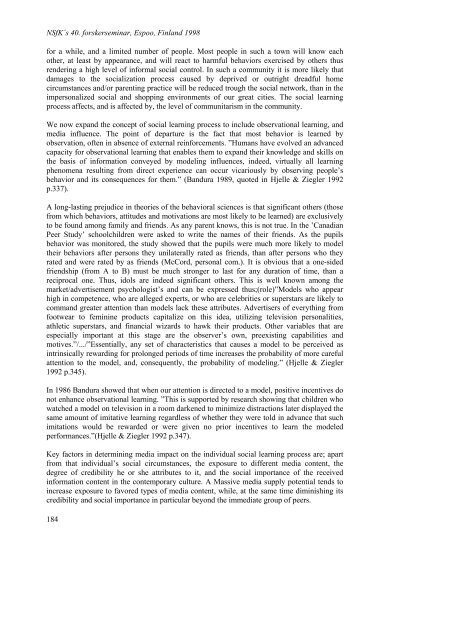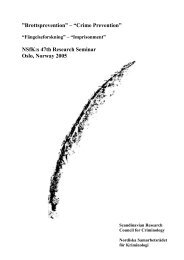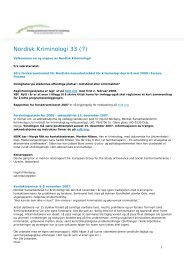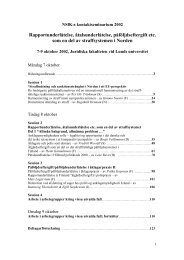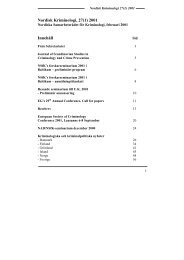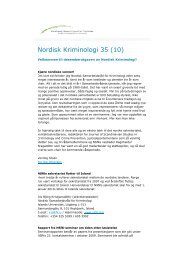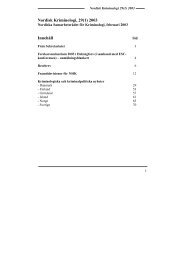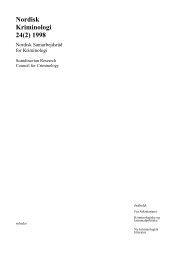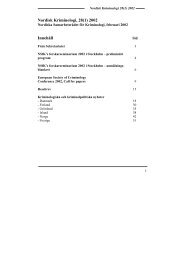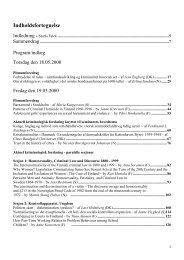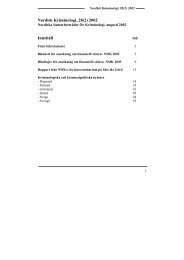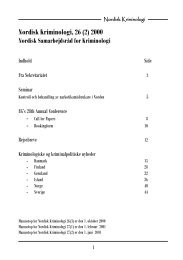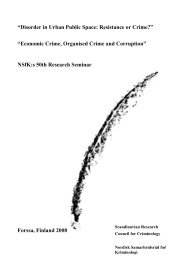Organised Crime & Crime Prevention - what works? - Scandinavian ...
Organised Crime & Crime Prevention - what works? - Scandinavian ...
Organised Crime & Crime Prevention - what works? - Scandinavian ...
Create successful ePaper yourself
Turn your PDF publications into a flip-book with our unique Google optimized e-Paper software.
NSfK´s 40. forskerseminar, Espoo, Finland 1998<br />
for a while, and a limited number of people. Most people in such a town will know each<br />
other, at least by appearance, and will react to harmful behaviors exercised by others thus<br />
rendering a high level of informal social control. In such a community it is more likely that<br />
damages to the socialization process caused by deprived or outright dreadful home<br />
circumstances and/or parenting practice will be reduced trough the social network, than in the<br />
impersonalized social and shopping environments of our great cities. The social learning<br />
process affects, and is affected by, the level of communitarism in the community.<br />
We now expand the concept of social learning process to include observational learning, and<br />
media influence. The point of departure is the fact that most behavior is learned by<br />
observation, often in absence of external reinforcements. ”Humans have evolved an advanced<br />
capacity for observational learning that enables them to expand their knowledge and skills on<br />
the basis of information conveyed by modeling influences, indeed, virtually all learning<br />
phenomena resulting from direct experience can occur vicariously by observing people’s<br />
behavior and its consequences for them.” (Bandura 1989, quoted in Hjelle & Ziegler 1992<br />
p.337).<br />
A long-lasting prejudice in theories of the behavioral sciences is that significant others (those<br />
from which behaviors, attitudes and motivations are most likely to be learned) are exclusively<br />
to be found among family and friends. As any parent knows, this is not true. In the ’Canadian<br />
Peer Study’ schoolchildren were asked to write the names of their friends. As the pupils<br />
behavior was monitored, the study showed that the pupils were much more likely to model<br />
their behaviors after persons they unilaterally rated as friends, than after persons who they<br />
rated and were rated by as friends (McCord, personal com.). It is obvious that a one-sided<br />
friendship (from A to B) must be much stronger to last for any duration of time, than a<br />
reciprocal one. Thus, idols are indeed significant others. This is well known among the<br />
market/advertisement psychologist’s and can be expressed thus;(role)”Models who appear<br />
high in competence, who are alleged experts, or who are celebrities or superstars are likely to<br />
command greater attention than models lack these attributes. Advertisers of everything from<br />
footwear to feminine products capitalize on this idea, utilizing television personalities,<br />
athletic superstars, and financial wizards to hawk their products. Other variables that are<br />
especially important at this stage are the observer’s own, preexisting capabilities and<br />
motives.”/.../”Essentially, any set of characteristics that causes a model to be perceived as<br />
intrinsically rewarding for prolonged periods of time increases the probability of more careful<br />
attention to the model, and, consequently, the probability of modeling.” (Hjelle & Ziegler<br />
1992 p.345).<br />
In 1986 Bandura showed that when our attention is directed to a model, positive incentives do<br />
not enhance observational learning. ”This is supported by research showing that children who<br />
watched a model on television in a room darkened to minimize distractions later displayed the<br />
same amount of imitative learning regardless of whether they were told in advance that such<br />
imitations would be rewarded or were given no prior incentives to learn the modeled<br />
performances.”(Hjelle & Ziegler 1992 p.347).<br />
Key factors in determining media impact on the individual social learning process are; apart<br />
from that individual’s social circumstances, the exposure to different media content, the<br />
degree of credibility he or she attributes to it, and the social importance of the received<br />
information content in the contemporary culture. A Massive media supply potential tends to<br />
increase exposure to favored types of media content, while, at the same time diminishing its<br />
credibility and social importance in particular beyond the immediate group of peers.<br />
184


